In a world where counterfeit currency remains a concern, being able to authenticate a $10 bill is a valuable skill. Whether you’re a business owner handling cash transactions or an individual receiving change, knowing the signs of a genuine $10 bill can protect you from financial loss and fraud. This guide will delve into the intricate details of U.S. currency security features, providing you with the tools to confidently identify the authenticity of a $10 bill.
Background on U.S. Currency
The $10 bill is part of the U.S. Federal Reserve Note series, commonly circulated alongside other denominations. Introduced with various security measures, these bills are designed to be difficult to replicate accurately. While counterfeiting technology has become more sophisticated, so have the methods used to protect currency integrity.
Identifying Genuine Features
Paper Quality: U.S. currency is printed on a specialized blend of cotton and linen fibers, giving it a unique feel. Hold a $10 bill up to the light; you should see the security thread embedded within the paper, running vertically to the left of the portrait. The paper should also be durable, with no tears or fraying edges.
Watermark: Hold the bill up to a light source. A genuine $10 bill features a watermark to the right of the portrait, visible from both sides of the bill. This watermark should match the portrait on the bill and can be seen more clearly when held up against light.
Color-Shifting Ink: Tilt the bill back and forth. The numeral “10” in the lower right-hand corner should shift from copper to green as you change the viewing angle. This color-shifting ink is a distinctive feature of authentic U.S. currency.
Security Thread: Each genuine $10 bill contains a thin embedded security thread running vertically. Hold the bill up to the light to see this thread, which is inscribed with the denomination of the bill and glows a specific color (blue) under ultraviolet light.
Microprinting: Examine the bill closely with a magnifying glass. Genuine bills have microprinting within the portrait and around the security thread. For example, on a $10 bill, the words “THE UNITED STATES OF AMERICA” are microprinted on the collar of Hamilton’s jacket.
3D Security Ribbon: Newer $10 bills (and those from other recent series) contain a blue security ribbon woven into the paper. This ribbon displays images of bells and “10” when held at an angle, making it difficult to replicate with standard printing methods.
Verification Techniques
Compare with a Known Genuine Bill: Keep a known genuine $10 bill for reference. Regularly compare any new bills you receive against this reference, paying attention to the specific security features.
Use Ultraviolet Light: Invest in an ultraviolet (UV) light to verify the presence and color of the security thread. Authentic bills will display a blue security thread under UV light.
Feel the Texture: Familiarize yourself with the unique feel of genuine U.S. currency. Counterfeit bills often feel smoother or lack the distinctive cotton-linen blend of authentic bills.
Utilize a Counterfeit Detection Pen: While not foolproof, counterfeit detection pens can be useful tools. These pens use iodine to detect starch in wood-based paper, which is not present in genuine U.S. currency. Be cautious, though, as advanced counterfeiters can coat bills to circumvent this test.
What to Do if You Suspect Counterfeit Currency
If you suspect that you have received a counterfeit $10 bill or any other denomination:
Do Not Pass it On: Refuse to accept the bill and explain your concerns politely.
Contact Authorities: Report the incident to local law enforcement or the U.S. Secret Service. They can provide guidance on next steps and investigate the issue further.
Document Details: If possible, take note of the bill’s appearance, where you received it, and any other relevant details. This information may assist authorities in their investigation.
See Also Is the Singapore Dollar Tied to the US Dollar?
Conclusion
The ability to identify a genuine $10 bill is a valuable skill in today’s world. By understanding the specific security features and employing verification techniques, you can confidently handle cash transactions while protecting yourself from fraud. Remember, if you encounter a suspected counterfeit bill, take the necessary steps to report it and prevent its circulation. Together, we can contribute to maintaining the integrity of our currency system.


